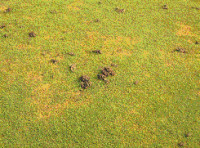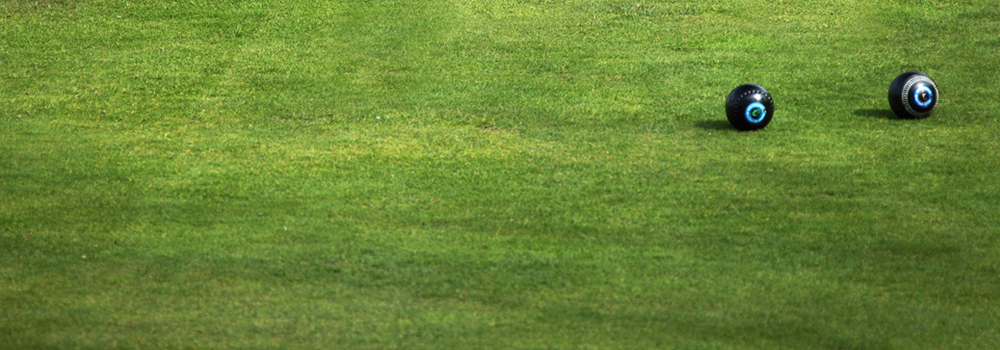
Spring renovations are four to six weeks away, so ensure you have ordered your top dressing and seed requirements, along with any specialist machinery you may need to hire in for the tasks ahead. Get your orders in early to avoid disappointment.
Key Tasks for February

- Dragbrushing when dew is present
- Clean out the ditches and repair surrounds
- Tip the grass with the mower if it grows above 12mm (1/2 inch)
- Aerate, if and when possible, and only if conditions are right (not on frozen or waterlogged greens)
Mowing the sward, preparing surfaces for renovation. Grass growth will be influenced by soil and air temperatures. Once we begin to see temperatures rising consistently above 8 degrees centigrade, grass growth will be stimulated and mowing will be required to maintain sward at between 8-12mm.
Fertilising. Soil temperatures should and will begin to rise towards the end of February/early March, enabling the grass plant to make use of any fertilisers being applied. The grass plant's transpiration/respiration rates need to be active to initiate movement of soluble solutions from the soil into and through the plant's tissue. To ensure you are applying the correct amount and balance of fertilisers for your turf, it would be useful to have a soil analysis undertaken, which will give you a full nutrient analysis of your soil's requirements. Based on these results, an appropriate fertiliser programme can be initiated for your facility.
Aeration. Over the winter months, and weather conditions permitting, you should be spiking the green 2-3 times per month, using 1/2" solid tines to a depth of 4".




As daytime temperatures potentially begin to warm, it is important to nurse the plant through the end of winter with a gentle amount of NPK fertiliser, either as little and often foliar applications or with a conventional release mineral fertiliser. The aim should be to keep the plant healthy, not to force growth, as excess nutrition will either go to waste when cold or force the plant on too much when warmer, in turn making soft young growth susceptible to damage from the harsh winds and temperatures during cold snaps and fungal attack in warm, damp, still periods.
Sulphur is an important nutrient when it comes to assisting plant metabolic function early in the season. So, planning now to apply a feed in March, which contains a high percentage of this vital element, should be considered.
Towards the end of the month, the sun may begin to feel noticeably warm in sheltered areas, but turf managers should be mindful that it is soil temperatures which drive growth with night time temperatures the biggest contributing factor to average soil temperatures throughout the day.
Put simply:
warm day and warm night = warming soil temperatures
warm day and cold night = stable soil temperatures
Keeping an eye on weather forecasts, and applying fungicides in good time when weather conditions are predicted to be the most conducive for disease development, is the best way to minimise damage. Once obvious damage is evident, applications are entering into a curative phase. The most effective and responsible approach is to aim for a preventative or early curative regime whereby diseases, and in particular microdochium patch, are treated prior to, or at the earliest signs of infection.
Aeration, as always, continues to be of utmost importance and should be undertaken whenever conditions allow good recovery and the risk of damaging wet soils is at a minimum.
If moisture and warmth coincide towards the end of the month, then it is an opportunity to seed any remaining small bare patches which might have lingered over winter, although germination will be slow especially if colder weather then intervenes.

With pests such as rabbits, foxes and moles it a case of identifying the problem and controlling their activities; employing approved pest control services to eradicate them from site may be a solution.
Brushing or switching of the playing surface keeps the green clean and removes any dew or surface water. Keeping the surface dry will aid resistance to disease.
The typical types of diseases you may come across are:
- Fusarium Patch
- Red Thread
- Fairy Rings
- Anthracnose
Use appropriate fungicides to control any further outbreaks, however, with the grass soon beginning to grow, it won't take long for these scars to grow out.
More information on these and many others can be found here: https://www.pitchcare.com/useful/diseases.php
It is important to maintain machines by carrying out regular servicing and repairs.
Remember to check the condition of your machinery, and plan to get it repaired/serviced during the winter months.
- Service and sharpen mowers ready for the new season; it is well worth the money investing in a winter service.
- Keep machines overhauled and clean.
- Inspect and repair any watering or irrigation systems; many bowling clubs now have pop-up irrigation systems, so ensure they have been drained down for winter. Organise an inspection, re-commissioning and calibration of the system in late February.

Pitchcare is the only provider of LANTRA accredited training courses in the maintenance of Bowls Greens.
We can also arrange Lantra accredited training on site to groups of 6 – 10 people. Email Chris Johnson for information.
Have a look at the new Grounds Training Website
- Check and service floodlighting systems; ensuring they are ready for the new playing season.
- It also important to replace any worn tines on your aeration equipment.
- Most bowling green facilities are enclosed by fences or hedges and now is a good time to tidy these up.
- Carry out any repairs to ditches, paths, gates and other building features.
- If the frosty weather persists over a number of days, it could lead to a number of problems within your irrigation systems, hose pipes and outside taps. Ideally, any water carrying pipe work should be lagged or protected from frost damage, as this will lead to burst pipes and joints; make sure you keep an eye open for these leaks.
Useful Articles:
https://www.pitchcare.com/magazine/spring-maintenance-of-bowling-greens-2009.html



